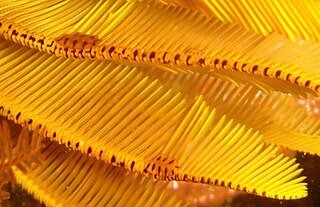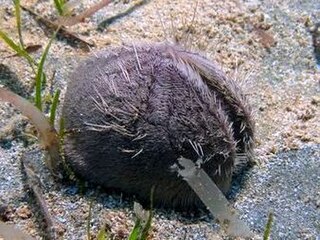
Sea spiders are marine arthropods of the order Pantopoda, belonging to the class Pycnogonida, hence they are also called pycnogonids. They are cosmopolitan, found in oceans around the world. The over 1,300 known species have leg spans ranging from 1 mm (0.04 in) to over 70 cm (2.3 ft). Most are toward the smaller end of this range in relatively shallow depths; however, they can grow to be quite large in Antarctic and deep waters.

The Aspidodiadematidae are a family of sea urchins.

The Myzostomida or Myzostomatida are an order of small marine worms, which are parasitic on echinoderms, mostly crinoids. These highly unusual and diverse annelids were first discovered by Friedrich Sigismund Leuckart in 1827.

Octopodiformes is a superorder of the subclass Coleoidea, comprising the octopuses and the vampire squid. All living members of Octopodiformes have eight arms, either lacking the two tentacles of squid or modifying the tentacles into thin filaments. Octopodiformes is often considered the crown group of octopuses and vampire squids, including all descendants of their common ancestor. Some authors use the term Vampyropoda for the same general category, though others use "Vampyropoda" to refer to the total group. Another term is Octobranchia, referring to cephalopods without prominent tentacles.

Carcharias is a genus of mackerel sharks belonging to the family Odontaspididae. Once bearing many prehistoric species, all have gone extinct with the exception of the critically endangered sand tiger shark.

Spectamen is a genus of small sea snails, marine gastropod molluscs in the family Solariellidae within the superfamily Trochoidea.

Coelopleurus is an extant genus of echinoids with fossil records dating back to the Eocene, with remains found in Europe and North America.

The heart urchins or Spatangoida are an order of sea urchins.

Cidaridae is a family of sea urchins in the order Cidaroida.
Vermetidae incertae sedis goreensis is a species of sea snail, a marine gastropod mollusk in the family Vermetidae, the worm snails or worm shells.
The order Pygocephalomorpha is an extinct group of peracarid crustaceans. Pygocephalomorpha were abundant from the Carboniferous era until their extinction in the Permian era.

Clypeaster, common name "cake urchins" or "sea biscuits", is a genus of echinoderms belonging to the family Clypeasteridae.

Asterocidaris is a genus of fossils sea urchins in the family Hemicidaridae. These epifaunal grazer-deposit feeders lived in the Middle and Upper Jurassic age.

Hemicidaridae is a family of extinct sea urchins characterized by large, massive, club-shaped spines.

Filifera is a suborder of hydrozoans in the order Anthoathecata. They are found in marine, brackish and freshwater habitats.

The clade Multicrustacea constitutes the largest superclass of crustaceans, containing approximately four-fifths of all described crustacean species, including crabs, lobsters, crayfish, shrimp, krill, prawns, woodlice, barnacles, copepods, amphipods, mantis shrimp and others. The largest branch of multicrustacea is the class Malacostraca.
Schizasteridae is a family of echinoderms belonging to the order Spatangoida.
Brissopsis is a genus of echinoderms belonging to the family Brissidae.
Paratanaoidea is a superfamily of malacostracan crustacean.














